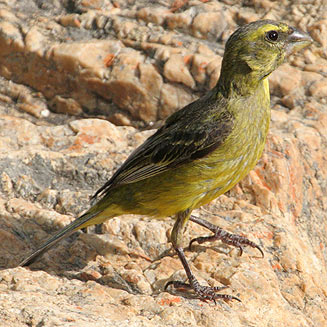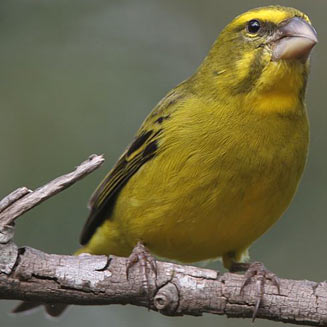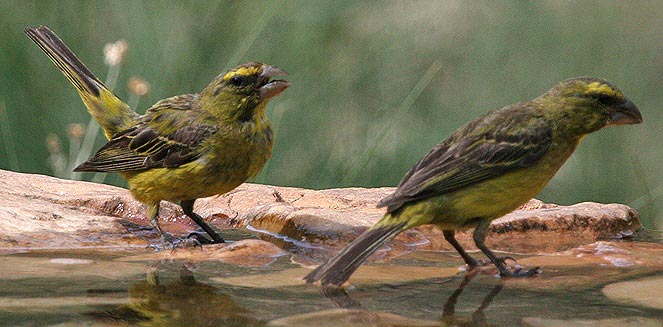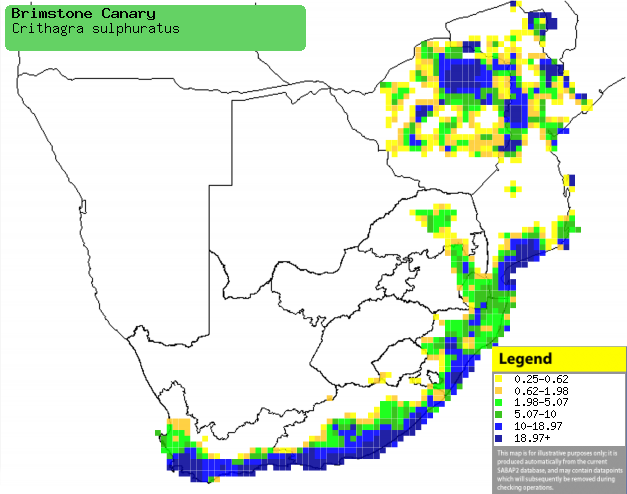|
Crithagra sulphuratus (Brimstone
canary, Bully canary)
[= Serinus sulphuratus]
Dikbekkanarie [Afrikaans]; Indweza (also applied to
Streaky-headed seedeater), Indweza Eluhlaza [Xhosa]; Zwavelkanarie [Dutch];
Serin soufré [French]; Schwefelgirlitz [German]; Canário-girassol [Portuguese]
Life
> Eukaryotes >
Opisthokonta
> Metazoa (animals) >
Bilateria >
Deuterostomia > Chordata >
Craniata > Vertebrata (vertebrates) > Gnathostomata (jawed
vertebrates) > Teleostomi (teleost fish) > Osteichthyes (bony fish) > Class:
Sarcopterygii (lobe-finned
fish) > Stegocephalia (terrestrial
vertebrates) > Tetrapoda
(four-legged vertebrates) > Reptiliomorpha > Amniota >
Reptilia (reptiles) >
Romeriida > Diapsida > Archosauromorpha > Archosauria >
Dinosauria
(dinosaurs) > Saurischia > Theropoda (bipedal predatory dinosaurs) >
Coelurosauria > Maniraptora > Aves
(birds) >
Order: Passeriformes > Family: Fringillidae
|
 |
 |
|
Brimstone canary, Duiwekloof,
Baviaanskloof Nature Reserve, South Africa. [photo H. Robertson, Iziko
©] |
Brimstone canary, Greyton, South Africa. [photo Trevor Hardaker ©] |
 |
|
Brimstone canaries,
Duiwekloof, Baviaanskloof
Nature Reserve, South Africa. [photo Duncan Robertson ©] |
Distribution and habitat
Occurs in patches from Uganda through southern and eastern
DRC, Tanzania, Angola and Zambia to southern Africa. Here it is fairly common in
Zimbabwe, Mozambique, Swaziland and eastern and southern South Africa, from
Limpopo Province south to KwaZulu-Natal and west to the Western Cape. It
generally prefers thickets, edges and clearings in coastal forest, montane
shrubland, old croplands, gardens and edges of alien tree plantations.
|
 |
|
Distribution of Brimstone canary in southern
Africa, based on statistical smoothing of the records from first SA Bird
Atlas Project (©
Animal Demography unit, University of
Cape Town; smoothing by Birgit Erni and Francesca Little). Colours range
from dark blue (most common) through to yellow (least common).
See here for the latest distribution
from the SABAP2. |
Predators and parasites
It has been recorded as prey of
Falco biarmicus
(Lanner falcon).
Movements and migrations
Resident and sedentary, although it may make
local movements in Winter.
Food
It mainly eats seeds and fruit supplemented with insects
and nectar, doing most of its foraging on the ground and in the vegetation of
trees and bushes. The following food items have been recorded
in its diet:
- Plants
- seeds
- Acacia
- Pinus (pine)
- Clutia pulchella (Warty-fruited clutia)
- Euphorbia triangularis (River euphorbia)
- Tribulus terrestris (Devil's thorn)
- Emex australis (Dubbeltjie)
- Chenopodium (misbredie)
- Ehretia rigida (Puzzle-bush)
- Eriocephalus (Karoo rosemaries)
- Euryops
- Othonna
- Ursinia (Asteraceae)
- Protea
- Stellaria (chickweeds)
- Raphanus (wild mustard)
- Pelargonium
- Psoralea (fountain-bushes)
- fruit
- Cassytha (false dodder)
- Scutia myrtina (Cat-thorn)
- Chrysanthemoides monolifera (Bushtick-berry)
- Cotoneaster
- Diospyros (jackal-berries)
- Ehretia (stamperwood)
- Ficus burtt-davyi (Scrambling fig)
- Lantana camara (Cherry-pie)
- Ligistrum (privet)
- Lycium (honey-thorns)
- Olea (olives)
- nectar
- Aloe marlothii (Mountain aloe)
- Erythrina latissima (Broad-leaved coral-tree)
- leaves
- Arctotheca calendula (Cape marigold)
- Senecio pleisthocephus (groundsel)
- Insects
Breeding
- Monogamous, territorial usually solitary nester, although it may breed in
loose colonies of up to 6 nest spaced 5-20 metres apart.
- The nest is built solely by the female, consisting of a cup of grass,
fine twigs, weed stems, tendrils from everlastings (Helichrysum),
leaf petioles, roots and hair and lined with plant down, wool, seed appuses
and other soft material. It is typically placed in the fork of a bush or
tree with sparse foliage, such as tall Euphorbia and alien pine trees
(Pinus), anywhere from about 1-6 metres above ground.
- Egg-laying season is from July-March, peaking from August-October.
- It lays 2-4 eggs, which are incubated solely by the female for about
12.5-17 days, while the male regularly feeds her at the nest.
- For the first four days the chicks are fed by the female with food
provisioned by the male, after which both sexes feed them. The young
eventually leave the nest at about 14-21 days old, remaining dependent on
the adults for food for some time afterwards.
Threats
Not threatened.
References
-
Hockey PAR, Dean WRJ and Ryan PG 2005. Roberts
- Birds of southern Africa, VIIth ed. The Trustees of the John Voelcker
Bird Book Fund, Cape Town.
|
